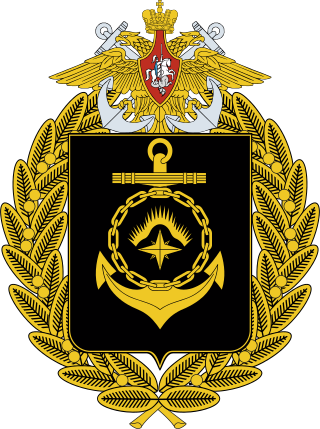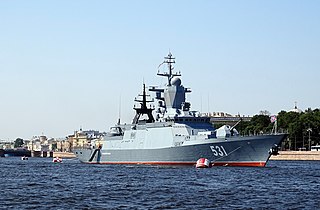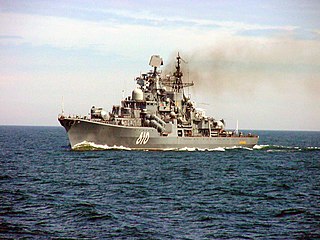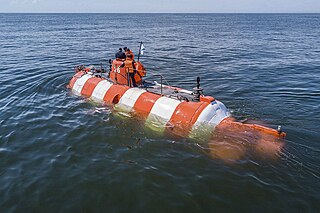
The Russian navy is the naval arm of the Russian Armed Forces. It has existed in various forms since 1696; its present iteration was formed in January 1992 when it succeeded the Navy of the Commonwealth of Independent States.

A deep-submergence vehicle (DSV) is a deep-diving crewed submersible that is self-propelled. Several navies operate vehicles that can be accurately described as DSVs. DSVs are commonly divided into two types: research DSVs, which are used for exploration and surveying, and DSRVs, which are intended to be used for rescuing the crew of a sunken navy submarine, clandestine (espionage) missions, or both. DSRVs are equipped with docking chambers to allow personnel ingress and egress via a manhole.

The Northern Fleet is the fleet of the Russian Navy in the Arctic.
The Priz class is a type of deep-submergence rescue vehicle (DSRV) operated by the government of Russia. There are known to be at least five vessels of the class, several of which were involved in the failed rescue attempt when the submarine Kursk sank on 12 August 2000. The Russian word "Priz" (“приз”) means "prize".

AS-28 is a Priz-class deep-submergence rescue vehicle of the Russian Navy, which entered service in 1986. It was designed for submarine rescue operations by the Lazurit Design Bureau in Nizhny Novgorod. It is 13.5 m (44 ft) long, 5.7 m (19 ft) high, and can operate up to a depth of 1,000 m (3,300 ft).

A deep-submergence rescue vehicle (DSRV) is a type of deep-submergence vehicle used for rescue of downed submarines and clandestine missions. While DSRV is the term most often used by the United States Navy, other nations have different designations for their vehicles.

Pyotr Velikiy is the fourth Kirov-class battlecruiser of the Russian Navy. She was initially named Yuri Andropov after Yuri Andropov, the former General Secretary of the Communist Party, but the ship's name was changed after the fall of the Soviet Union. The Russian designation for the type is "heavy nuclear missile cruiser", but Western defense commentators have resurrected the term "battlecruiser" to describe them, as they are the largest surface "line of battle" warships in the world. Pyotr Velikiy is the flagship of the Northern Fleet.

The Russian cruiser Marshal Ustinov, is a Slava-class cruiser of the Russian Navy. The Russian name for the ship type is Raketnyy Kreyser (RKR), meaning "Missile Cruiser". The ship is named after Dmitriy Ustinov, a former Soviet Minister of Defence. Marshal Ustinov was assigned to the 43rd Missile Ship Division of the Russian Northern Fleet, whose homeport is in Severomorsk. From 2012 to 2016, the cruiser underwent a major overhaul. The vessel returned to service in 2017 and has since been deployed to the Mediterranean Sea.

The Steregushchiy class, Russian designation Project 20380, is a class of corvettes being built for the Russian Navy. Designed by the Almaz Central Marine Design Bureau, subsequent vessels were built to an improved design, incorporating the Zaslon-Redut SAM system. The ship full displacement and dimensions are large for a corvette, thus it is designated as a frigate by NATO. The Steregushchiy class has been further developed into the Gremyashchiy class and Project 20386 subclasses. The export variant is known as Project 20382 Tigr.

The Point class is a class of six roll-on/roll-off sealift ships originally procured under a Private Finance Initiative to be available for use as naval auxiliaries to the British armed forces. Two of the ships have now been released from the contract, leaving four available for service with the military.

Admiral Flota Sovetskogo Soyuza Gorshkov is an Admiral Gorshkov class frigate of the Russian Navy and the lead ship of the class.

Soobrazitelny is the second ship of the Steregushchy-class corvette built for the Russian Navy in the early 21st century.

Kommuna is a submarine salvage ship in service with the Russian Navy's Black Sea Fleet and the world's oldest active duty naval vessel. A double-hulled catamaran, she was laid down at the Putilov Factory in St. Petersburg in November 1912 as Volkhov. The ship was launched the following year, and commissioned on 14 July 1915. She was renamed Kommuna on 31 December 1922. Kommuna has served in the Russian Imperial, Soviet, and Russian Federation navies through the Russian Revolution and two World Wars.

The Karakurt class, Russian designation Project 22800 Karakurt, is a class of Russian corvettes which have been entering service with the Russian Navy since 2018.

Nastoychivy is a Sovremenny-class destroyer of the Soviet and later Russian navy. Previously she was named Moskovsky Komsomolets before being renamed on 15 February 1992.

Stoikiy is a Steregushchiy-class corvette of the Russian Navy.

Merkury is a Steregushchiy-class corvette of the Russian Navy. The original name for the corvette was Retiviy prior to 2021.

On 26 September 2022, a series of underwater explosions and consequent gas leaks occurred on the Nord Stream 1 (NS1) and Nord Stream 2 (NS2) natural gas pipelines, two of 23 gas pipelines between Europe and Russia. Both pipelines were built to transport natural gas from Russia to Germany through the Baltic Sea, and are majority owned by the Russian majority state-owned gas company, Gazprom.

AS-26 is a Priz-class deep-submergence rescue vehicle (DSRV), or rescue mini-submarine, which went into service in 1987. The DSRV first entered service with the Soviet Navy but became part of the Russian Navy after the dissolution of the Soviet Union.























